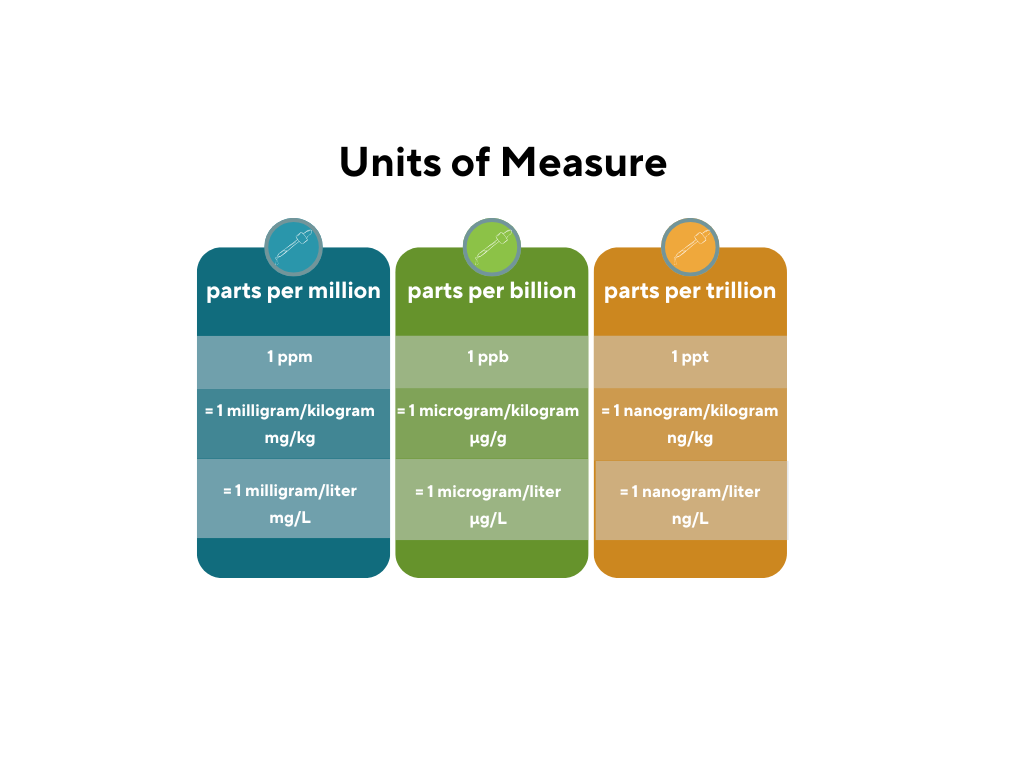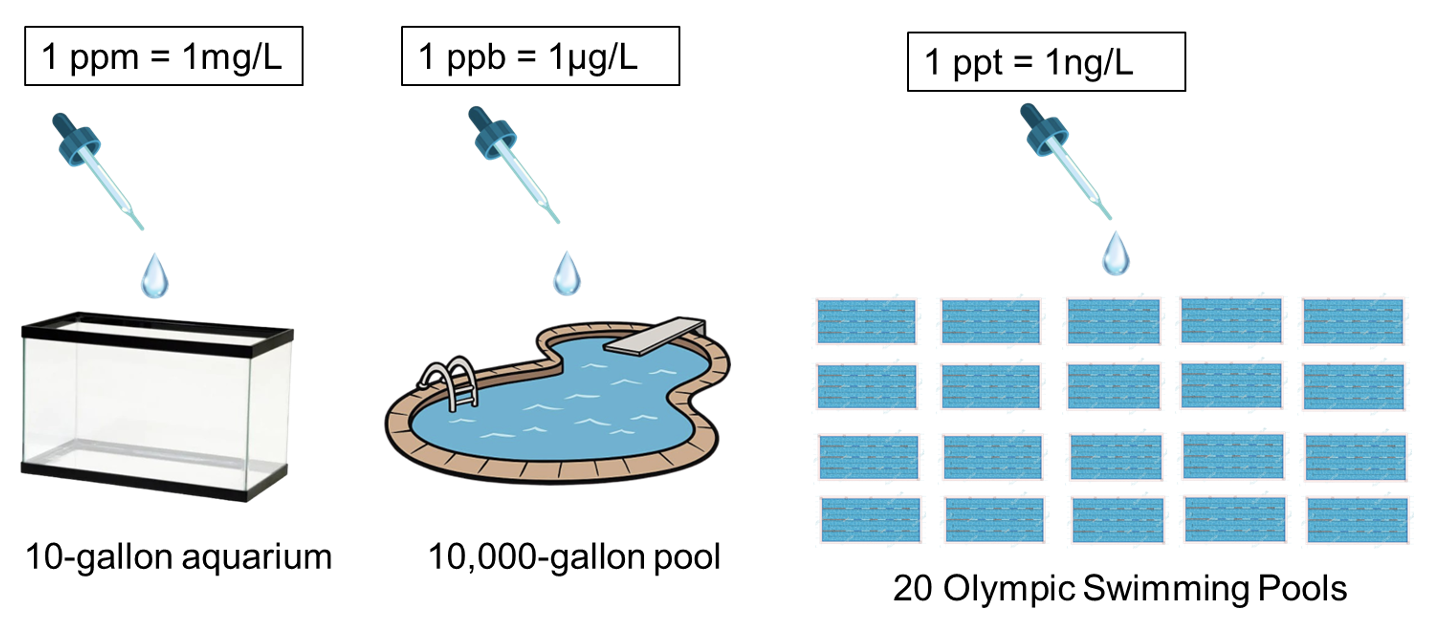Michigan's Response
Research
Leaders at Michigan State University understood that we needed to research solutions for the PFAS contamination issue and this would require involvement and collaboration of researchers from several disciplines. The Center for PFAS Research was created in 2020 to investigate the impacts of PFAS contamination across multiple different sectors of our daily lives and involves several disciplines and colleges. The main research topics include investigating agricultural impacts, identifying PFAS alternatives, environmental monitoring, modeling, food safety, risk assessment, outreach, education and identifying health impacts in humans, fish, and wildlife. The Center for PFAS Research also established an Analytical Laboratory to measure PFAS in various sample types and is designed to serve both the public and private sector. To learn more about scientists and ongoing research at Michigan State University, please visit the Center’s website.
Regulations
Michigan is leading the nation on trying to keep PFAS out of our soil and water to protect public health.
Establishment of MPART
On February 4, 2019, Governor Gretchen Whitmer signed Executive Order 2019-3, establishing the Michigan PFAS Action Response Team (MPART) as an enduring body to address the threat of PFAS contamination in Michigan, protect public health, and ensure the safety of Michigan's land, air, and water, while facilitating inter-agency coordination, increasing transparency, and requiring clear standards to ensure accountability. MPART is comprised of seven state departments, including: Michigan Department of Military and Veterans Affairs (MDMVA), Michigan Department of Environment, Great Lakes, and Energy (EGLE), Michigan Department of Health and Human Services (MDHHS), Michigan Department of Natural Resources (DNR), Michigan Department of Agriculture and Rural Development (MDARD), Michigan Department of Transportation (MDOT), Michigan Department of Licensing and Regulatory Affairs.
These agencies are working with federal and local partners to conduct investigations to identify areas and sources of PFAS contamination throughout the state and ensure appropriate public health responses. To view a map of known PFAS sites and Areas of Concern visit the MPART website.
PFAS and Drinking Water
Michigan was one of the first states in the nation to regulate PFAS chemicals in drinking water beginning in 2020. The Michigan Department of Environment, Great Lakes, and Energy (EGLE) developed Maximum Contaminant Levels (MCLs) for seven PFAS compounds in Michigan, which took effect in August 2020. These MCLs amend existing rules for public drinking water supplies under Michigan's Safe Drinking Water Act (SDWA), affecting approximately 2,700 public water supplies statewide. Approximately 75% of Michigan residents get water from a public water supply and the remaining 25% are on private wells. Private wells are not routinely monitored by the state, nor subject to the drinking water standards. It is highly recommended that residents test private wells see SAMPLING section.
Learn more about Michigan’s maximum contaminant levels (MCLs) for seven PFAS compounds under the authority of the Safe Drinking Water Act here.
In April 2024, the Environmental Protection Agency established legally enforceable levels for six PFAS in drinking water: PFOA, PFOS, PFHxS, PFNA, and HFPO-DA, and PFAS mixtures containing at least two or more of PFHxS, PFNA, HFPO-DA, and PFBS to account for the combined and co-occurring levels of these PFAS in drinking water. The federal rules go beyond Michigan’s standard of limiting PFOA and PFOS to 8 and 16 ppt, respectively, with a standard of 4 ppt each.
As a reminder, 4 ppt is 4 parts per trillion or 4 nanograms per liter.

Another way to think about it is 4 drops into 20 Olympic sized swimming pools is enough for human health concerns!

According to the EPA rule, public water systems must monitor these PFAS and have until 2027 to complete initial monitoring, followed by ongoing compliance monitoring. Water systems must also provide the public with information on the levels of these PFAS in their drinking water beginning in 2027. Public water systems have five years (2029) to implement solutions that reduce these PFAS if monitoring shows that drinking water levels exceed limits. Public water systems that have PFAS in drinking water which violates one or more of these limits must take action to reduce levels of these PFAS in their drinking water and must provide notification to the public of the violation by 2029.
More info about the EPA’s final rule on drinking water standards can be found on the EPA website.
Biosolids
Many industries discharge to municipal wastewater treatment plants (WWTP) rather than discharge directly to surface waters or groundwater. Unfortunately, conventional WWTP treatment does not effectively remove PFAS. Instead, PFAS may pass through treatment to lakes, streams, and groundwater, as well as interfere with management of solids from the treatment process referred to as sludge or biosolids, dependent on the disposal method.
The major sources of PFAS at WWTPs come from industries that have used PFAS-containing chemicals (such as chrome platers and paper manufacturers) and industrial users that may have accepted wastes that used PFAS-containing chemicals in their processes and/or products (such as landfills and centralized waste treaters). Although chemical manufacturers in the United States voluntarily stopped making PFOS and PFOA years ago, these persistent chemicals may be found in factories years after they were used. Sites contaminated by firefighting foams or PFAS-contaminated industrial wastes have also been found to be sources for WWTPs when they discharge to the sanitary sewer.
Part of EGLE's approach to addressing PFAS in biosolids is to identify sources of PFAS within wastewater treatment plants (WWTP) and to control or eliminate them at the source. Preliminary efforts at source control implemented through the Industrial Pretreatment Program PFAS Initiative have been successful in reducing PFAS inputs to wastewater treatment systems thereby reducing the potential for PFAS to accumulate in solids generated at the plant. EGLE's Water Resources Division (WRD) has added PFAS sampling into routine NPDES permit compliance sampling inspections to further understand the prevalence of PFAS in wastewaters of Michigan.
To address the potential that municipal WWTPs could be passing elevated levels of PFAS through their treatment systems to lakes, streams, and groundwater, EGLE launched the IPP (Industrial Pretreatment Program) PFAS Initiative in February 2018.
The IPP PFAS Initiative required all municipal WWTPs with required IPPs (95 statewide) to find out if they were passing PFOS and/or PFOA to surface waters or groundwater and, if found, to reduce and eliminate any sources. This initiative requires source reduction at confirmed sources, accomplished through pollutant minimization plans, equipment/tank change out/clean outs, product replacement, and installation of pretreatment to remove PFAS, specifically PFOS, prior to discharge.
To view an interactive map of the monitoring results for the 95 Wastewater Treatment Plants with required Industrial Pretreatment Programs in Michigan can be found on the interactive map.
EGLE is supporting the EPA's efforts to complete a risk-based evaluation of PFAS in biosolids. While the EPA is completing their evaluation of biosolids, EGLE will continue an approach which focuses on identifying and reducing significant sources of PFAS entering wastewater treatment systems, preventing the land application of industrially impacted biosolids, mitigate risks and continue driving PFAS concentrations present in biosolids down as quickly as possible.
The MPART Land Application Workgroup is now expanding this effort to evaluate PFAS in the land application of other (non-biosolids) residuals and industrial byproducts/sludges.



 Print
Print Email
Email